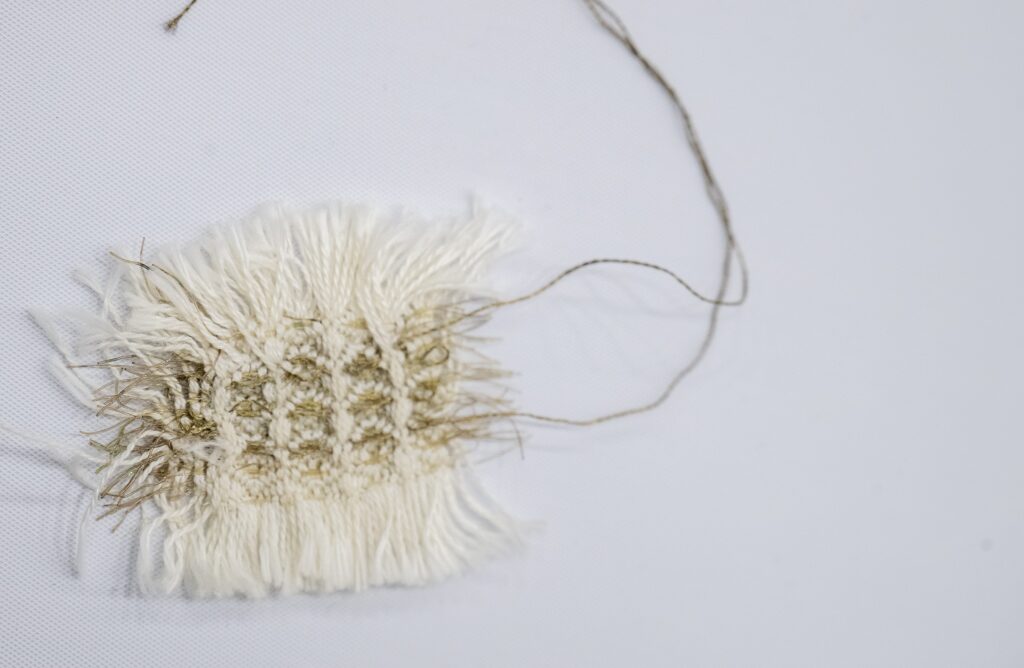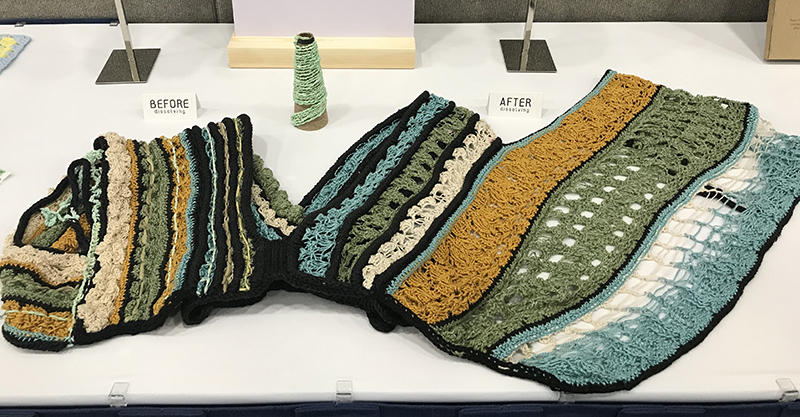
This year’s Emerging Technologies Conference, presented by the Advanced Textiles Association (ATA) had a clear focus on the topics on everyone’s minds, with sessions addressing sustainability and PFAS updates, smart textiles and e-textile technology, biomaterials, artificial intelligence, health and wellness markets, and textiles needed for space missions. Additional sessions were presented on the show floor, with exhibitors near-at-hand to answer questions and guide attendees with the most current information and products.
A DIY biomaterials workshop
Attendees at the conference had the opportunity to make their own biomaterials in a workshop led by Eldy Lazaro, Ph.D. candidate at the University of Colorado Boulder. Lazaro has devised a way to make e-textiles more recyclable and presented her research in a session titled, “Crafting biomaterials for interactive interfaces.”
Bio-based materials are derived or sourced from renewable biological matter, such as plants, animals, bacteria and fungi. Lazaro’s research is based on Agar-agar, a jelly-like material made of polysaccharides biopolymer that are extracted from the cell walls of some red algae species. It is commonly used as a food gelling agent or thickening, and a vegan substitute for gelatin.
Following her formula and using a few simple steps, workshop participants made the fundamental material for the fiber from Agar-agar, adding glycerin, water, and food-safe dye for color. A few seconds in the microwave, and the material was “set” by the end of the session.
The theory, which is surprisingly simple, is to create a fabric woven from a plant-based material for the warp, such as cotton, with her Agar-based material as the weft. Among the weft fibers are conductive fibers. As the agar-based fibers dissolve in warm water, the material will come apart, the cotton can be recycled, and the conductive fibers can also be retrieved and reused, creating the possibility for single-use, sustainable woven sensors. It could also be useful for single-use, adhesive sensors commonly used to monitor the heart.
One of Lazaro’s challenges was making the yarn itself, so she created her own biofibers spinning machine and open-sourced it. She’s also used the technology to create gelatin biofibers with a photosensitive color-changing coating.
At the prototype level, this all makes sense, but obviously it would need a coating to be more durable for longer-term functionality. However, Lazaro has experimented with incorporating the bioplastic in fashion garments where the changes precipitated by heat or water are an integral part of the product’s design.
The workshop also produced a biofoam, which has been used to make the casing for a pressure sensor. At the end of the product’s life, the biofoam can be dissolved in water and the conductive materials retrieved with a magnet.

The case for hemp
According to Lelia Lawson, a researcher at the University of Alberta, Canada, and a research and development specialist with Davey Textile Solutions Inc., the demand for cellulosic fibers will grow so substantially by 2030 that there will be a “cellulose gap” not met by other natural or synthetic fibers, and she asks, “Can hemp be the answer?”
In her presentation at the Emerging Textiles Conference, “Effects of pretreatments on hemp stalk processing towards lyocell fiber manufacturing,” she pointed out that hemp has been cultivated for thousands of years and asks, “so, why are we not growing it now?” Hemp “grows like a weed,” she says, and offers unique benefits. Unlike some fast-growing plants, such as bamboo, hemp will grow almost anywhere. It also requires less water, fertilizers, herbicides and pesticides than other agricultural crops, and it can be used as a rotational crop to improve soil health.
Hemp is one of the strongest natural fibers, Lawson says, but it’s also breathable, gets softer with each washing, is naturally antimicrobial, biodegradable, and all parts of the plant can be used. The next logical question is, “Why are we not wearing it?“ Part of it is simply education, she says. Also, there are new regulations regarding hemp.
But a more basic challenge is that the fiber is coarse, and requires multiple-stage processing. “It may require ‘cottonization’ to make it comfortable by breaking down lignins, which can be expensive,” she says.
The U.S. and Canada have turned to manmade cellulosic fibers, such as lyocell. “It’s a very comfortable fiber,” she says, and although it’s expensive, it’s safer and more sustainable than viscose, for example, which is not manufactured in Canada or the U.S. because the process uses poisons.
Lyocell fibers can be manufactured from any high alpha-cellulose feedstock, offer a closed-loop system for solvent recycling, biodegradability with no microplastics, and versatility. “Imagine blending hemp bast fibers with lyocell from hemp!” she says. “It produces upwards of 250 percent the biomass of cotton and 600 percent the biomass of flax on the same land mass.”
The process for making a useable fiber from hemp starts with straw retting right in the field at harvest and continues naturally, or with water or a chemical treatment. But that is just the beginning of a process that not only produces a fiber, but it also reclaims waste product to be used in other ways, including in biofuels, pharmaceuticals, foods, cosmetics and bioplastics.
With a 20 million metric ton deficit in cellulose expected, she says there is the potential for a $50–70 million industry by 2030. The problem, as with many emerging (or re-emerging) materials, is funding for scaling up.
Janet Preus is senior editor of Textile Technology Source. She can be reached at janet.preus@textiles.org.
 TEXTILES.ORG
TEXTILES.ORG


